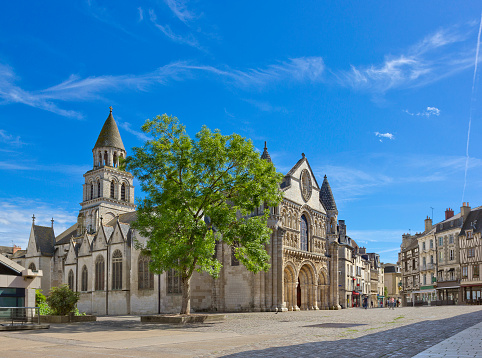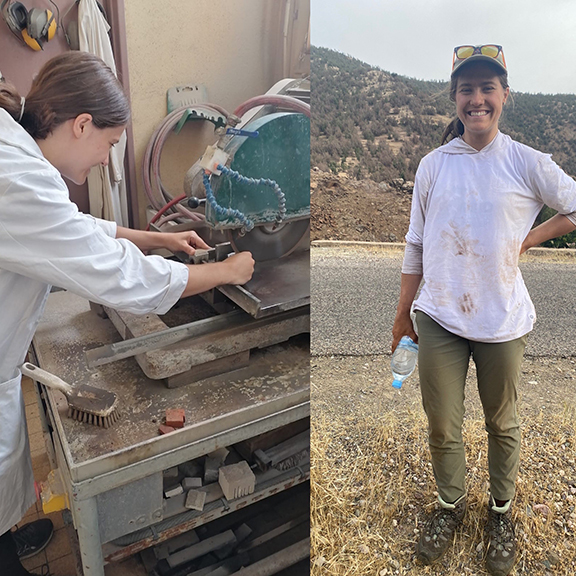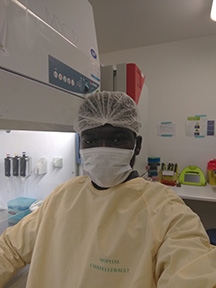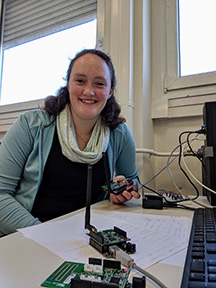STEM Track
STEM students are integrated into the Université de Poitiers through both classes and participation in research projects within university labs.
The STEM track will run through spring 2026. STEM options are also available in Paris.
Students take the Middlebury Language Pledge® to accelerate their French language proficiency.

Overview
This program is meant for students who have completed the equivalent of at least five semesters of college French and who are majoring in one of the following fields:
Biology
Chemistry
Computer Science
Engineering Science
Environmental Sciences
Geology
Mathematics
Molecular Biology and Biochemistry
Neuroscience
Physics
Academic Structure
Students take three courses in STEM, one French language class and a history course organized by Middlebury.
Annual students obtain 8 to 9 units of credit, while semester students obtain 4 to 5 units, depending on their course selection and on whether or not they complete a STEM research project within a laboratory (see details below).
Full Academic Year
Early September-Mid May
Total 8 units
Three STEM courses (3 units) each semester
Language course (0.5 units)*
Middlebury French History course in the fall and an elective in the spring (0.5 units)
*Students who place out of the language requirement may take an elective course instead.
Fall or Spring Semester Only
Early September-Mid December
Early January-Mid June
Total 4 units
Three STEM courses (3 units)
Language course (0.5 units)*
Middlebury French History course (0.5 units)
*Students who place out of the language requirement may take an elective course instead.
Optional Lab Research Project in the spring semester only (1 unit)
Early May-mid June
Students may apply to do an optional Lab research project in May-June. The process is very competitive (two or three spots per year for Middlebury students).
Lab Research Projects are only offered to program students who enrolled in third-year courses during the semester.
Application deadline: October 15th of each year for the following spring.
OBJECTIVES, TERMS AND CONDITIONS OF THE LAB RESEARCH PROJECT
The first objective of the Lab Research Project is to introduce students to research. They join a research team in one of the university labs, one to which their semester course / curriculum is attached, and are given an assignment / a project, a small research topic. They work under the supervision of a professor (*professeurencadrant) and often work in collaboration with other trainees (master’s or doctoral students, or even post-docs).
The Lab Research Project lasts a minimum of five weeks. The starting date (in May) varies, according to the preferences of the supervising research professor. Students are expected to work 35 hours a week (full-time) in their host lab.
PROJECT REPORT
Students write a Lab Research Project report in French or in English under the guidance of their supervising professors. The report is read and graded by that same professor. The project is defended in the same way as for other Université de Poitiers undergraduates (usually during the second week of June).
Click here for the syllabus for this research project.
For a full list of Université de Poitiers research labs, please click here:
https://sfa.univ-poitiers.fr/recherche/les-laboratoires-de-recherche/


Past Research Projects
Ecologie et Biologie des Interactions (EBI) Lab
Sophia Trone
I worked with a professor and a graduate student on a long-term project on terrestrial isopods, known as pillbugs, roly-poly bugs, or woodlice. Wolbachia is a parasite that can infect the woodlouse Armadillidium vulgare. The project I am working on examines how selective forces drive unique Wolbachia sub-populations, and what mechanisms drive the adaptation of Wolbachia to the micro-environments within the woodlice that they colonize. My project specifically included the quantification of Wolbachia in the host tissues of the woodlice that had already been injected with Wolbachia coming from various organs of other woodlice. My work consisted of a literature search to familiarize myself with important articles in the parasite/symbiosis field, taking care of the woodlice, and learning about and conducting dissection of the woodlice, DNA extraction and running qPCR tests to quantify the Wolbachia in the woodlice. All of the work I have conducted in this project was absolutely fascinating and the chance to conduct DNA extraction and qPCR analysis is very important to my future ecology research opportunities. I loved the fact that everyone in the lab spoke to me in French, and that they were all very kind, welcoming and helpful as well. I also had the incredible opportunity to attend, for free, a 3 day conference centering around symbiosis, parasites, and evolution. This conference was almost entirely in French, and gave me a chance to hear from many professors, researchers, and graduate and pHD students about their research.
Shawn Bayrd
Secondary metabolites are organic compounds not directly involved in growth, development, or reproduction, but that can sometimes be useful in protection, metal transporting agents, agents of symbiosis between organisms, sexual hormones, or even differentiation effectors. Lately, these metabolites have been sought after in the search for new antibiotics against quickly transforming pathogens that have evolved resistance against many of our already known and practiced agents. Acanthamoeba castellanii are free-living amoeba found on the human body and various other environments that encyst from a trophozoite form when the environmental conditions become unsatisfactory. This amoeba can cause rare and severe infections in the eye, skin, the central nervous system, and various other locations on the human body. We first measured antibiotic resistance against E. coli and P. fluorescens, and then against human carcinoma lung tissue cells.
Ascel [the professor] created a very conducive learning environment throughout this short internship by having me help out other research projects in the adjacent laboratories to see and do science on several projects and fields. This was a very exciting project as Ascel created a new research assay where no published science has really gone before in order to see if there would be future prospects for studying. While my work was short and so far inconclusive, I’m happy to say that I learned a lot during my time in his lab and I have hope that our work may lead to a new antibiotic resistance.
Bryce Williamson
I am working with a graduate student and a professor on a long-term project on terrestrial isopods, also known as pillbugs, rolly-pollies or woodlice. These critters are found all over the world and play an important ecological role as detritivores. The goal of the research is to better understand how pillbugs might avoid inbreeding through their partner choice. My work so far has consisted mainly of maintaining the pillbugs and performing experiments where I record their behavior using a special computer program. The entire lab team is extremely friendly, which makes for a great work environment. The work itself has been fantastic as well, since arthropods are one of my main interests in ecology and I have always found bugs fascinating! Later on in the internship I will also be performing chemical analyses on bee samples in an unrelated project for the same professor, which should give me some experience with more technical work. The whole experience has been fantastic also because I get to speak in French all the time, which I love! It is truly a very immersive experience.
Data Analysis and Computations Through Imaging Modeling-Mathématiques, Imagerie, Santé DACTIM-MIS Lab, part of the Laboratoire de Mathématiques et Applications (LMA) Lab
Katherine Kulp
Magnetic resonance imaging and spectroscopy (MRI/MRS) are common clinical diagnostic tools that currently operate at magnetic field strengths of 3 tesla (T) and below. However, in 2017, ultra-high field strength at 7T was approved for clinical use in the US and the EU. La Centre Hospitalier Universitaire (CHU) de Poitiers is first clinical platform and the third research platform in France to offer 7T imaging in conjunction with 3T. Researchers at the Data Analysis and Computation Through Imaging (DACTIM) laboratory hope to further develop techniques related to ultra-high field, multiorgan, multinuclear metabolic imaging.
With that in mind, my objective as a stagiaire was to investigate the proposed benefits and challenges associated with 7T magnetic resonance (MR) including higher resolution images and improved diagnostic confidence. At the end, I presented a comprehensive comparison of the effects of 3T and 7T field strength on various MR technologies, including proton, 13C, and 31P MRS as well as sodium and relaxation mapping.
Overall, this internship was an incredible experience. My supervisor, Carole Guivellin, Ph.D., as well as the entire DACTIM-MIS team, were very welcoming, patient, and knowledgeable. The laboratory itself is located in the cardiac wing of the university hospital in Poitiers, which was a very energizing and educational environment. I gained a wealth of new French vocab pertaining to clinical practices and MR, and was pleased to have an immersive language experience. I thoroughly enjoyed observing clinics with the MRI technicians and working on my research in the lab. However, my favorite part was when I attended a research conference hosted by DACTIM and their partners, where I got to collaborate with many brilliant students, researchers, and professors from all over the world. I would highly recommend the stage experience to any future Midd students at Poitiers. I am so grateful that I could be a part of such innovative research!
HYDRASA / IC2MP Lab
Molly Arndt
The discovery of an exceptionally preserved Artiopoda specimen from the central High Atlas Mountains of Morocco introduced questions regarding the paleoenvironmental conditions of the Early Cambrian period in Morocco. In this project, I investigated the conditions of this exceptional fossil preservation by performing field work and mineralogic and petrographic analyses. Stratigraphic analysis provides insight into sea level changes during the Early to Middle Cambrian periods. Mineralogic analysis emphasizes the impact of volcanism on the section, particularly on ash deposit layer where the exceptionally preserved specimen was found.
During this project, I spent 6 weeks working with Professor El Albani from the HYDRASA lab at the University of Poitiers. I spent 5 weeks doing lab work, including grinding up rocks into dust and performing x-ray and microscope analysis. I had the incredible opportunity–thanks to funding from the Middlebury College Geology Department–to travel to Morocco for a week during my internship to collect samples and field notes from the site in a rural part of the High Atlas Mountains of Morocco. This internship was an incredible way to meet amazing people (particularly the other stagiaires!), develop research skills and a final research paper and presentation, and learn more about research in France! I would highly recommend this experience to anyone studying in Poitiers, it’s truly a one-of-a-kind opportunity.
Ischémie Reperfusion en Transplantation d’Organes Mécanismes et Innovations Thérapeutiques (IRTOMIT) Lab
Laurent Asiama
I interned in the IRTOMIT lab (Ischémie Reperfusion en Transplantation d’Organes Mécanismes et Innovations Thérapeutiques) under the supervision of Dr. Patrick Hannaert, and Dr. Clara Steichen.
My lab experience has indeed been fun, engaging and challenging at the same time. This experience gave me the opportunity to work closely with a professional clinical team which investigates ischemia/reperfusion injuries relating to organ transplantation. Here, I was able to not only assist but directly familiarize myself with various lab protocols. Some of the analysis I was fortunate to perform includes, culturing human renal cells, determining renal cell proliferation with chemical and enzyme-based assays, extracting and measuring ATP from porcine kidney samples, and many more. Moreover, I was able to improve my proficiency in French since this experience compelled me to find efficient ways to communicate with my supervisors and other laboratory personnel. I can therefore say without a doubt that I gleaned a lot from the team and this has even amplified my interest for medicine and research.
Laboratoire d’informatique et d’Automatique pour les Systèmes (LIAS) Lab
Abigail Stone
I’m working on a long-range low-power internet of things implementation project. In this architecture, remote devices send messages to a gateway device via LoRa modulation, which in turn relays the data to an application server hosted on the web. If the gateway device doesn’t receive a transmission, the device re-emits on a different frequency channel (which consumes additional power). The goal of the research is to optimize the power consumption and data reliability of the end devices. My work has included testing several variations of this architecture, including building a local gateway as well as testing end devices with gateways that have already been deployed locally. Overall it has been an incredible experience and I’ve learned a lot about the research process. It’s also been a great opportunity to improve my technical writing in French!

